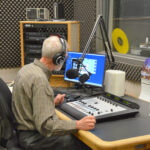
Covid has changed our lives in many different ways. For example, school has developed onto many new platforms online. This allowed students to continue their education during quarantine. Zoom and other teaching methods helped teachers successfully educate their students online. Unfortunately, there are classes that simply cannot convert to an online format. These include hands-on art courses such as Glassblowing and Studio Lighting.
During the Spring Semester of 2020, art instructor Christopher Grey had to move all of his classes to an online format. Without his equipment from the studio, students were unable to work with glass at all. To compensate for the lack of access to equipment, Grey gave his students research assignments of famous glass artists, as well as research projects utilizing special techniques on paper that would help them understand the fundamentals of glass. There were also sculpting projects from materials assigned to complete at home.
However, with all of his efforts to simulate the studio environment instruction wasn’t the same as being in a physical space, Grey said. However, he says his goal was to keep everyone’s spirits high during such uncertain times. “I thought it was difficult because I lost that student and teacher in class relationship. It was hard to stay connected with the class,” said Ethan Dunn, a Liberal Arts major in the glass blowing class.
Glassblowing wasn’t the only art class with such difficulties. During the fall of 2020, one of Christine Flavin’s classes had to be canceled. Studio Lighting was canceled due to the confined space the equipment is in and no option for online.
But despite this impediment, some other art classes were more successful online. As a result, Greta Songe said she was able to convert a lot of her classes to an online platform from previous online teaching experience and having students take material packages home.
“Our studio classes have always relied on face to face meetings in the art studio space. So, I had to create a lot of very detailed demonstrations to post on Youtube in order to capture some of the things we do in the studio. I also had to figure out ways to mimic our more casual flow in the face-to-face classroom with mini critiques, work in progress checks via Talon, and other methods,” said Songe.
She added, “This helped to have students connect with one another and show progress as they worked on the projects before the final deadline. I also made A LOT of feedback videos. In face to face classes, I can just grab a pencil and sketch on someone’s design to show them how to correct something. So, I tried to do that via Youtube feedback videos for a lot of projects. I have over 200 videos on Youtube now. Yikes.”
She said she was happy about everything she was still able to teach online even though there were many hardships in everyone’s personal lives.
“In a lot of ways, I was surprised by how well some things worked. My students have worked really hard in this time period, in spite of some really challenging life situations. I’m really proud of their efforts. We’ve all had to adapt and figure out how to teach and learn in this new situation. Now, I have a lot of materials that can be used again. If someone misses class, I now have demos for them. Before, that was a lot harder to manage.”

Categories: Campus News, COVID-19, News










